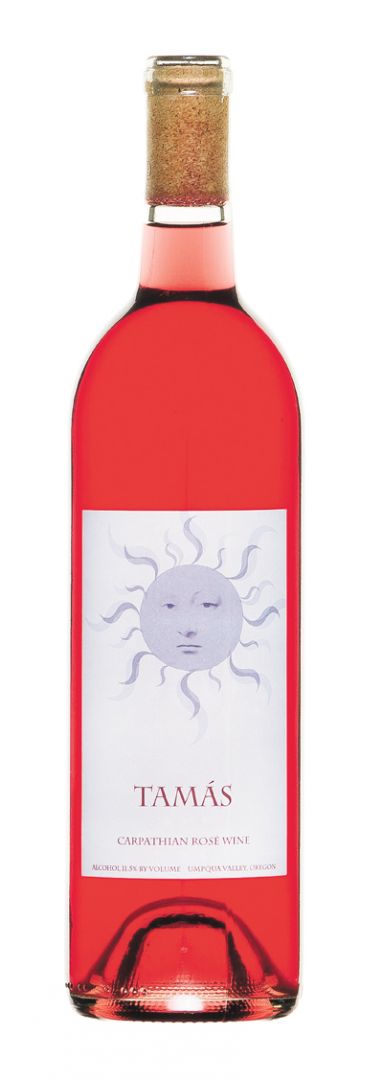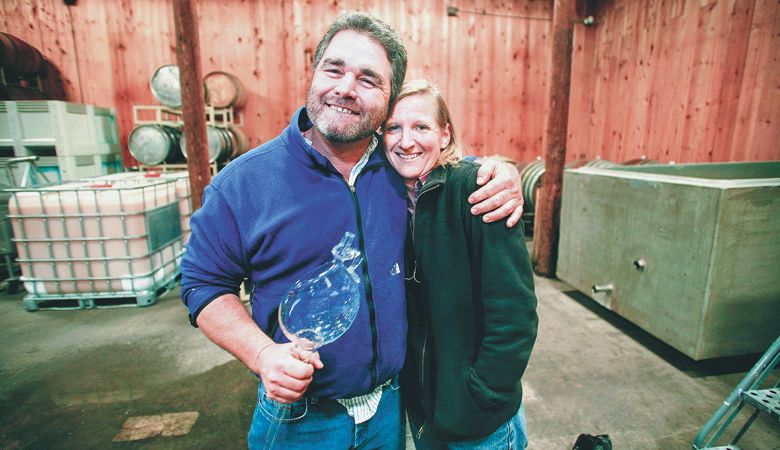Giggling Good
HillCrest rosé is the glee we all need
Changing the vibe of this strange year may require an offering to the gods. I have the perfect sacrificial bottle: a non-vintage wine from the Umpqua Valley that honors the “rosé king of Hungary” with an ancient northern Italian grape.
Allow me to introduce to you HillCrest Vineyard’s Tamás Carpathian Rosé. The back label should include the following advice from the late Dr. Hunter S. Thompson: “When the going gets weird, the weird turn professional.”
The Teroldego grapes used to make the Tamás are from Dyson and Susan DeMara’s HillCrest estate vineyard in Roseburg. Their inspiration resides 6,000 miles away in the tiny Hungarian village of Sióagárd, the home of Dúzsi Tamás, the undisputed king of Hungarian pink wines.

In 2009, DeMara traveled the wine regions of Hungary with fellow Umpqua Valley winery owner Gabor Palotai. When they hit Tamás’ winery, his majesty was waiting with 15 different rosés to taste. It was their final stop on a hot July day, and palate fatigue was already an issue.
Then, Tamás asked his guests, “One, two, three or four?”
Two glasses half-filled with a chilled, dark-colored rosé sat in front of them. Their host was asking how many parts of carbonated water he should add to their fröccs before he made a toast. A fröccs, which oddly enough rhymes with “church,” is Hungary’s take on a wine spritzer. “It energizes you. It makes you thirsty for wine again,” DeMara explained.
The wine itself sets this beverage apart from the ordinary counterpart DeMara describes Tamás’ wine as being high acid, low alcohol, yet not lacking in the fruit department. When he returned home to Oregon, DeMara was eager to share the thrill of the fröccs with his wife.
The American rosés he used were somewhat high on the sweetness scale to accurately replicate the exhilarating Hungarian drink. DeMara decided he would make his own wine, named in honor of Tamás, to prepare a proper fröccs.
DeMara picks the fruit for the Tamás at 2.9 pH to achieve what he describes as “searing acid.” He also aims for approximately 11% alcohol by volume. Unfortunately, his first attempt missed the mark. “I used Grenache, which was nice but at that low a level of ripeness, it just didn’t have much of a fruit component,” DeMara said
A small plot of Teroldego vines on DeMara’s property provided the solution. “Teroldego is a dark-skinned grape that develops a lot of flavor at super-low sugar levels, which is perfect when you are picking at a lower pH. It’s also like Zinfandel in that it gives up its color easily,” DeMara said. His latest Tamás is 100% Teroldego and clocks in at 11.5% alcohol.
Teroldego traces its lineage in the Trentino region in northeast Italy as far back as the 14th or 15th centuries. It is likely best known in America for the brilliant Italian wines made by Elisabetta Foradori. Teroldego is also a “passion variety” for DeMara.
For a grape to earn passion status, it has to pass Demara’s giggle test. “The first time I encounter a profound wine, I giggle. Like when I tasted a great Burgundy for the first time,” DeMara said. His passion epiphany occurred when he tasted a Teroldego wine made in California.
Scott Kelley, DeMara’s partner in the Paul O’Brien Winery in Roseburg, made a “tasting room only” Teroldego while working at the La Famiglia di Robert Mondavi in Oakville. It definitely made DeMara snicker.
When Kelley moved to the Umpqua Valley, DeMara asked him to bring 50 Teroldego plants with him. Those original vines, planted in 2001, have expanded to three acres.
“I have a lot of varieties at HillCrest to toy with,” Demara said, “but, honestly, Teroldego is the most interesting grape of them all.”
The HillCrest Tamás is definitely the most interesting $28 you will spend this year. The wine’s color is a cross between hibiscus tea and black cherry Kool-Aid. The color demands a swimming pool and a floating tray.
The aromatic show begins with musk melon and grilled watermelon. As the wine warms, the fruit transitions to not-quite-ripe raspberries being stomped by leather Doc Marten sandals on a concrete sidewalk. Floating in the background are scents of straw and my grandmother’s favorite cure for chigger bites: Sea Breeze.
The fruit pedal hits the metal with the first sip. Every taste receptor cell you have will work overtime, interpreting caramel apple slices and tangerine flavors duking it out with a slightly savory meatiness. There’s even a little sativa-like herb note for added interest. Brisk acidity is joined by mildly puckering tannins.
I’ve never encountered an American rosé like the Tamás. I want more.
The Changeup, a monthly column by Michael Alberty, is a baseball pitch designed to disorient and confuse. It’s the perfect representation of the unknown and its mastery over those who think they know what to expect. This column is devoted to those unorthodox Oregon wines you never saw coming.











